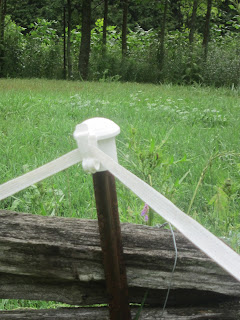This is not to scale, but I thought I'd take a post to explain our pastures.
We've got 4.8 acres, and I believe we've got a little under 4 acres in the paddocks (not bothered to go out there and measure yet).
The thin-lined in black fences currently exist & they are wood & field wire with electric poly-tape. I'm hoping to replace the field-wire with no-climb, but that's the last thing we'll do.
Front Paddock
 |
Only thing it's missing is a
good bush-hog! |
This is the paddock my horse is in right now. It's post & field wire with T-posts where it's too swampy (there is a stream bed mid-way back) or the terrain changes too quickly for wood post. We've strung electric tape all along the top of the fence. This if the field I would most like the change to no-climb.
This fence is about 5' high, which is okay. In a perfect world, it would 6' because I've got quite the little jumper (there is brush on all exterior fences so I doubt she'll ever try it). There is also a lower line of galvanized wire (pre-existing) This is not ideal for horses, but, like most fences, it's really only dangerous when it's loose. We are going to replace it with a second line of tape when the rest of the fence is done.
You'll probably notice we did most of the corners of an angle, that was on purpose. The first reason being that it is supposed to be psychologically better for horses not to have corners in their fields, more importantly it prevents one horse from trapping another in the corner to kick/bite at them causing serious damage. The second reason is that it provides a sheltered area (away from any larger animals) for the sheep & goats. So if they are being chased for some reason, they've got a safe place to hide.
 |
This fence needs to be
replaced in the
near future. |
Middle Paddock
Right now the back & middle paddocks are one, but when we replace the back paddock exterior fence we'll use those T-posts to divide these fields.
The middle pasture has 7' T-posts along the back, there is an exterior fence of wood post & field wire but it is so over-grown we weren't going to be able to string the electric along it with out some MAJOR chain-sawing. Instead we've cut off the back 4' of the field with the T-posts.
We lost a lot of space doing that, but we're going to create a run-way area that the goats & sheep can get into so they'll have their own space. Plus they can keep the grass/weeds down in that area.
 |
| Middle Pasture |
Back Paddock
This paddock has a T-post and wire fence, presumably put up when they severed off 90 acres from the farm about 10 years ago. This is not a very good exterior fence. It's only about 4' tall and it's both wobbly and already damaged from deer. It will keep the cows in, but it will never keep the horse in.
Hopefully this year, but maybe next, we'll be replacing the whole thing with wood post & no-climb fencing, then stringing electric on the inside.
Light-blue area
I'm considering preparing this area as a possible future quarantine site in case we purchase any livestock at auction. It's already quite sheltered from pig-sty here but we'll probably locate the lean-to shelter for this paddocks back in this area. The cedar-rail fence will prevent a lot of contact but when we've got an animal we want to quarantine we'll put a row of step-in electric fence posts to keep all the animals separate. It's also near the barn so convenient for water & feed, plus I can keep a good eye on our new occupants.
Lane-way
Adding a lane-way like this to your layout just makes turn-out/ changing paddocks a little simpler. We'll also use it as a paddock for the smaller animals (goats & sheep or "free-range" birds) in the summer and this area will serve as a sacrifice paddock for the cows in the winter/early-spring.
Yellow area
The Yellow area is an over-hang from the barn that is currently filled with wood, but already has chicken-wire so was obviously used for birds in the past. We're going to set this up (probably next year) so that we can put the meat-birds under there for shelter, then let them out to range in the pastures during the day.
Sac. (Sacrifice) Paddock
 |
Right now the goats & billy live out
in the sacrifice paddock.
They're doing a great job
taking down the weeds! |
This is a pre-existing paddock and it's got a lovely cedar rail fence, very safe! We also added two-strands of electric just to keep the animals off it.
The purpose of this paddock is to provide turn-out in the late-fall/winter/early-spring. During these times of year your grass does not grow very quickly, and combined with wet-weather, heavy hooves can destroy the sod. So you
sacrifice a small area of your land to provide some exercise space, which probably won't ever grow very much/any grass. The lack of grass is not necessarily a bad thing, lots of people use stone-dust or sand in their sacrifice paddock since they know nothing is going to grow, and this can help with drainage.
In the summer time we'll use this area for our pigs but right now it's holding the sheep & goats while we get the fences all up to par (they're a sneaky bunch!).
















